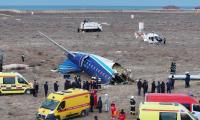Recently, in the context of the withdrawal of American and Nato forces from Afghanistan, we heard many US officials warn about ‘over the horizon’ (OTH) capacity in order to ‘deter’ the Taliban from attacking during the withdrawal process.
The use of the term ‘over the horizon’ is a new addition to the vocabulary of warfare. The fact that it was first used by official spokespersons and not academics or journalists points to its significance. The world has already witnessed US bombers flying from bases in the US to bomb Iraq and Afghanistan and return to the US after completing 36-hour-long missions.
We have also seen how the country employed a multitude of armed drones, which were guided from Centcom, Florida. Clearly, pointing to these capabilities long available to the US is not the core of the latest American message. So, then, what is new about this ‘over the horizon’ war? This is what I discuss in this article. I posit that OTH is an entirely new and evolving paradigm of waging future wars with air, space, and land components. (It also has a naval component which I do not treat.)
The first time the OTH war concept was employed was in the 1999 Yugoslavia War. In this war, the US defeated a modern army without encountering a single death. Since the Yugoslav war, we have seen two more conventional wars with elements of initial OTH capabilities. These were the 2001 US-Afghanistan and the 2003 US-Iraq wars. Then, we saw a fully OTH war against Libya in 2011, but with considerable covert and special forces participation. In all these wars, we see the steady evolution of the OTH paradigm.
In the air, for tactical attack, it relies either on advanced unmanned drones entirely or alongside a piloted stealth aircraft flying beyond the reach of the adversary that would coordinate and guide a swarm of drones to attack enemy positions. Combat drone technologies have been vastly improved in terms of payloads, endurance, and range, and these weapons will be even more important in future. Additionally, OTH envisages the use of long-range stealth bombers, both manned and unmanned, for mass destruction purposes.
On the ground, the OTH paradigm underlines that none or minimum ‘boots on the ground’ are used in the conduct of war, especially in its active combat phase. The rapid evolution of robotic unmanned ground fighting vehicles makes this possible. These would be air-dropped from global range transport planes and then remotely controlled to battle with enemy forces from afar. Another notable development is the continuing development of the US Joint Special Operations Command (JSOC). Today, the JSOC is a fully fleshed-out combat branch and has been relied upon increasingly. It oversees its own special mission units along with the US army’s Delta Force, navy’s SEALs, air force’s Special Tactics Squadron, and ‘deep reconnaissance’ intelligence support units. The JSCO also works closely with the CIA’s ‘Special Activities Center’. The JSOC performs ‘highly classified’ operations. To date, it has been employed in Afghanistan, Pakistan, Iraq, Libya, and sub-Saharan Africa.
Perhaps the most stunning dimension of the OTH war paradigm is the expansion of warfare from its historic three-dimensions – land, sea and air – to a fourth one: space-based warfare. America’s X-37B programme is one known example. There are also reports of new satellite technologies that can guide bombs and missiles from their launch sites onto remote targets. The recent demonstrations of similar technologies by mega private corporations Amazon, Virgin Atlantic, and soon Space-X, are further evidence of this. These are practical demonstrations to prove the viability of near-space vehicles as bombers. Clearly, one can plausibly conclude that the development of space and stratospheric bombers is just a matter of time.
A further factor in OTH wars is the development of advanced nuclear bombs. Although much secrecy surrounds them, it is understood that these bombs have achieved both super miniaturisation of bomb size and radical reduction in explosive yield. Carried by fighter-bombers, these are purposed to destroy specific hardened targets, thus lowering the nuclear threshold. Such a sub-total nuclear attack on an adversary would prove fatal to it.
The single most important factor behind the evolution of OTH has been the rapid and radical progress in electronic and nano technologies. This has led to an intensification of computing powers, real-time communications and data exchange, and advanced sensors which together have provided ‘human-like intelligence’ to killing machines. Artificial Intelligence or AI is now a fully evolved field and progressing rapidly. Even though AI has important civilian applications, states are more interested in its applications in warfare. With huge defence budgets, governments are likely to selectively guide the further development of AI towards war-related applications in future.
The essential purpose of the OTH paradigm is to wage a war without suffering any causalties (or ensuring that the number of causalties is minimum) while simultaneously ensuring that enemy forces are defeated. This is a revolutionary development in the history of war as all wars up till now have had, as their basis, the reality of human and material losses. This logic has historically deterred every state, even the relatively powerful, to choose war as the first option. With OTH, this logic holds no more.
Such a one-sided capacity to wage would certainly create an entirely different terrain and calculus of diplomacy and conflict. How this would happen cannot be discussed here, but this is a crucial point that cannot be overemphasised. OTH needs to be fully investigated by strategic thinkers as it will have serious ramifications for less powerful countries.
The writer is professor emeritus, Department of Political Science and Public Administration, Northern Michigan University.
Postman argues that “typographic mind” was yielding to “televisual mind”
Pakistan is well poised to meet opportunities that Artificial Intelligence will offer for developments in industries
Smog isn’t merely 'environmental' issue anymore, it is public health emergency, socioeconomic burden
As it evolves into Next Generation Air Force, PAF draws strength from its rich history and lessons learned from past...
Local govts of Punjab and WASAs as service delivery agencies are responsible for planning, providing services
Survey conducted in prisons highlights distinct patterns of crime shaped by socio-economic and demographic factors







